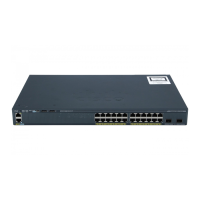4-7
Catalyst 2960 and 2960-S Switches Software Configuration Guide, Release 15.0(1)SE
OL-26520-01
Chapter 4 Configuring Cisco IOS Configuration Engine
Configuring Cisco IOS Agents
Note For more information about running the setup program and creating templates on the Configuration
Engine, see the Cisco Configuration Engine Installation and Setup Guide, 1.5 for Linux:
http://www.cisco.com/en/US/docs/net_mgmt/configuration_engine/1.5/installation_linux/guide/
setup_1.html
Enabling the CNS Event Agent
Note You must enable the CNS event agent on the switch before you enable the CNS configuration agent.
DHCP server
• IP address assignment
• TFTP server IP address
• Path to bootstrap configuration file on the TFTP server
• Default gateway IP address
TFTP server
• A bootstrap configuration file that includes the CNS
configuration commands that enable the switch to
communicate with the Configuration Engine
• The switch configured to use either the switch MAC address
or the serial number (instead of the default hostname) to
generate the ConfigID and EventID
• The CNS event agent configured to push the configuration file
to the switch
CNS Configuration Engine One or more templates for each type of device, with the ConfigID
of the device mapped to the template.
Table 4-1 Prerequisites for Enabling Automatic Configuration (continued)
Device Required Configuration

